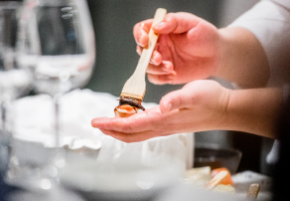- About
- Programs
- Campus Life
- Career Services
- Admissions
- News & Events
- Alumni
How to Grill Fish Without Sticking or Falling Apart
Learn how to grill fish like a pro with these step-by-step tips. Find the best fish, marinades, and grilling methods. Try it today!
Key Takeaways
- Successful fish grilling depends on proper preparation, thoughtful seasoning, and careful temperature control from start to finish.
- Fish is delicate and can stick or fall apart easily, which makes grilling more challenging than other cooking methods.
- Firm varieties such as salmon, tuna, swordfish, halibut, and mahi-mahi withstand the heat of the grill without losing structure.
- Common mistakes include overcooking, failing to oil the grates, and moving the fish too often before it naturally releases.
There are plenty of fish in the sea, and just as many ways to enjoy them at the table. Of the many cooking techniques, grilling, in particular, adds an irresistible smoky flavor that enhances the natural taste of the fish.
However, many people shy away from grilling fish. Compared to beef or chicken, it's a more delicate type of meat that can stick to the grate or break apart if not handled with care. That's why knowing how to grill fish properly is crucial if you want to try this cooking method. With the right methods, you can preserve its tender texture and bring out flavors that guarantee a dish worth savoring.
Why Grilling Fish Can Be Tricky
The challenge with fish isn't simply that it's delicate—it's how its structure reacts to heat. Unlike red meat, which has abundant connective tissue that firms up as it cooks, fish muscle fibers are shorter and loosely bound. This gives fish its tender, flaky texture, but it also means that it can separate and fall apart quickly if moved before it has seared.
Temperature control is another key factor. Fish cooks rapidly, and even slight differences in heat across the grill can leave one side perfectly done while the other turns dry. On top of that, the same natural oils that make fish flavorful are prone to bonding with hot metal, causing the dreaded sticking that pulls away the surface layer of the fillet.
Choosing the Best Fish for Grilling
The outcome of grilling fish largely depends on picking the right type. Firm varieties handle high heat better, staying intact on the grate and giving you more control during cooking. Delicate fish can still be delicious, but they often break apart too easily to make grilling enjoyable. That's why choosing sturdier options gives you a far better chance of success.
Some of the best choices for grilling include:
- Salmon: rich in natural oils that keep the flesh moist and flavorful
- Tuna: dense and firm, with a steak-like texture that cooks quickly
- Swordfish: meaty consistency, making it an excellent option for beginners
- Halibut: mild flavor and firm structure that holds together well
- Mahi-mahi: firm-textured fish that adapts to many seasonings and styles
- Snapper: slightly sweet, firm enough for grilling, and takes on marinades beautifully
- Trout: tender yet resilient when grilled whole, with a distinct earthy flavor
- Mackerel: oily and firm, perfect for high-heat grilling and bold seasoning
Once you've chosen the type of fish, its cut also influences the success of your dish. Whole fish hold moisture better because the skin and bones act as natural insulators, locking in juices and protecting the flesh from direct heat. They also make for a dramatic presentation on the plate. Fillets, on the other hand, offer practical benefits: they cook more evenly, are easier to flip without breaking, and allow for consistent portion sizes.
The choice between these two options often comes down to the occasion: whole fish, when presentation and moisture matter most; fillets, when convenience and precision are the priority.
Freshness is another factor that you must consider. Fresh fish typically offers the best texture and taste, especially when it's locally sourced or recently caught. But not everyone has easy access to that quality. Well-frozen fish is often a more realistic option in everyday markets, and it can still deliver excellent results, as long as it's thawed gradually and handled with care.
Steps to Grilling Fish
What often feels tricky about grilling fish becomes much simpler once you break it down into clear steps. Preparation, seasoning, and careful handling are all necessary to turn a delicate piece of fish into a flavorful, perfectly cooked dish.
Start Your Culinary Journey
Learn the art of cooking in a world-class environment
Step 1 – Prepare the fish
A few small details at the start make all the difference once the fish hits the heat. To prepare it, you should begin by cleaning your fish thoroughly and patting it completely dry with paper towels. Excess moisture creates steam, which prevents searing and increases the chance of sticking.
For fillets, trim uneven edges so they cook evenly, and use tweezers or small pliers to remove any lingering pin bones. If you're working with a whole fish, make sure it's properly scaled, and then score the skin in a crosshatch pattern. This prevents the skin from curling and helps heat penetrate more evenly.
Step 2 – Season or marinate
Seasoning helps enhance taste and creates a protective coating that keeps the fish from bonding with the grill. A simple mix of salt and pepper works well, but marinades can add layers of flavor and help retain moisture. Keep the marinating time short (around 15–30 minutes), as longer periods can soften the flesh too much and lead to mushiness.
Some marinade options you can use include:
- Olive oil with lemon and fresh herbs
- Soy sauce, ginger, and sesame oil
- Garlic, oregano, and a splash of white wine
- Chili flakes with lime juice and cilantro
- Mustard, dill, and olive oil
- Coconut milk with curry spices
- Honey, miso, and rice vinegar
Step 3 – Prepare the grill
A properly prepared grill makes the whole process much smoother and reduces frustration. So, preheat your grill to medium-high (around 200–230°C or 400–450°F) so the grates are hot enough to sear quickly.
Use a sturdy brush to clean off any residue from previous use, then oil the grates generously. The easiest way is with a paper towel dipped in neutral oil and held with tongs.
For thinner fillets, direct heat works best, giving you a quick sear and preventing overcooking. Thicker cuts or whole fish may benefit from indirect heat, where they cook more gently without burning on the outside.
Step 4 – Place fish on the grill
If your fish has skin, start by placing it skin-side down on the grates; the skin acts as a natural shield and holds the fillet together. Lay the fish at a 45-degree angle to the grates for attractive grill marks, but avoid adjusting it once placed to avoid breaking it apart.
For more delicate fish, use a fish basket or place the fillet on a piece of foil brushed with oil. These tools will provide the needed extra support and make flipping less stressful, especially for beginners.
Step 5 – Cook and flip carefully
Grilling fish is about precision, not guesswork. Therefore, as a guideline, allow 10 minutes of cooking time per inch of thickness, usually 4–6 minutes per side for fillets. Watch for visual cues rather than just the clock: the edges should turn opaque and the fish should release easily from the grate. If it still clings, give it more time before flipping.
Use a wide, thin spatula when turning the fish. Support the fillet gently with your other hand if necessary. One confident motion is better than multiple small adjustments, which often lead to tearing.
Step 6 – Check for doneness
Fish cooks faster than most proteins, so paying attention is critical. The flesh should be opaque and flake easily. An internal temperature of 63°C (145°F) ensures safety, though pulling the fish off the grill just shy of this number is often best for the resting period.
Properly done fish will feel firm but still moist, breaking into flakes when pressed lightly.
Step 7 – Rest and serve
Just like meat, fish benefits from a brief resting period. Allow it to sit for 2–3 minutes after grilling to let the juices redistribute and the texture stabilize. This makes serving cleaner and the eating experience more enjoyable.
Plate your grilled fish with simple garnishes that brighten the flavor, like lemon wedges or a light sauce. For sides, grilled vegetables, rice pilaf, or crisp salads balance the smokiness and round out the meal beautifully.
Common Mistakes to Avoid
There are a few common mistakes people make when grilling fish that can easily be avoided with the right approach. Some such mistakes include:
- Overcooking the fish: Fish cooks quickly and becomes dry and tough when left on the grill too long. Monitor cooking time carefully and use a thermometer if you're still learning.
- Not oiling the grill grates: Insufficiently oiled grates cause sticking and torn fillets. Clean, hot, well-oiled grates are essential for keeping the fish intact.
- Moving the fish too much: Constantly shifting or flipping prevents proper searing and increases the chance of breaking. Place your fish on the grill and let it cook undisturbed until it's ready to release naturally.
- Marinating for too long: Extended marinating, especially with acidic ingredients like lemon juice or vinegar, breaks down the flesh and leaves it mushy. Keep it to 15–30 minutes.
- Skipping preheating: Putting fish on a grill that hasn't reached the right temperature leads to sticking and uneven cooking. Always allow the grill to heat fully before adding fish.
Bring Your Grilled Fish to the Next Level
Mastering grilled fish takes the right mindset, plenty of patience, and thorough preparation. At Culinary Arts Academy Switzerland (CAAS), students discover that these same principles are the foundation of all great cooking.
Through hands-on practice guided by expert chefs, our students develop their culinary skills and expand their creativity. Our Bachelor's in Culinary Arts and Swiss Diploma in Culinary Arts programs combine classical training with modern techniques, preparing graduates to thrive in kitchens across the globe.
At CAAS, education is more than skill-building—it's the recipe that transforms culinary passion into a lifelong profession.
Frequently Asked Questions
Is it better to grill fish with the skin on or off?
Skin-on is generally better as it protects the delicate flesh and helps hold the fillet together during cooking.
Can you grill frozen fish directly?
Technically, yes—firm fillets like salmon or cod can be grilled from frozen with a foil packet and extra time. But most chefs avoid it, since thawing first delivers more even cooking, better texture, and a superior result on the grill.
What’s the best wood for grilling fish?
Cedar, alder, or fruit woods provide mild, complementary flavors without overpowering delicate fish.
Interested in becoming a world-class chef? Learn more about Culinary Arts Academy Switzerland. Download our brochure.





















